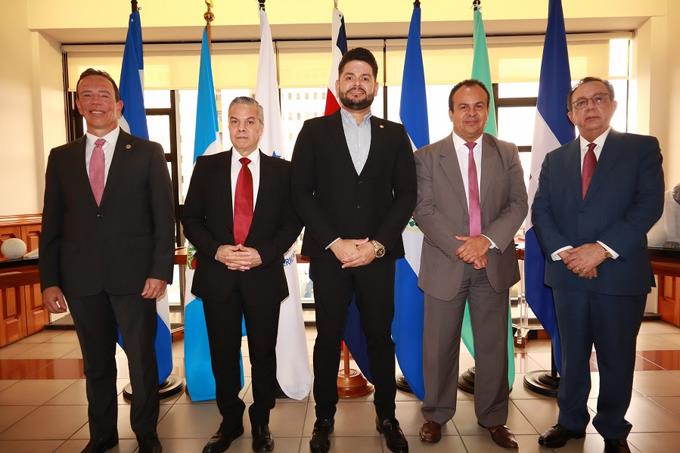The Governor of the Central Bank of the Dominican Republic (BCRD), Hector Valdez Albizuit was elected for the fourth time president of the Central American Monetary Council (CMCA)during the 296 Ordinary Meeting of that regional organization, a meeting in which Odalis Marte, the first Dominican to hold that position, was also elected executive secretary of the CMCA.
Valdez Albizu also participated in the IX Joint Meeting of the CMCA and the Central American Council of Superintendents of Banks, Insurance and other Financial Institutions (CCSBSO).
Both meetings were held in a hybrid mode, the days November 24 and 25in the city of San José, Costa Rica, with the participation of the presidents and governors of the central banks of the region, as well as government officials and officials, who evaluated the performance and economic prospects of the countries of Central America and the Dominican Republic, among other aspects.
The 296th Meeting of the CMCA began with the welcome words of the president of the Central Bank of Nicaragua and outgoing president of the CMCA, Ovidio Reyes Ramírez, by those of Róger Madrigal, president of the Central Bank of Costa Rica, and those of Domingo González, executive secretary outgoing CMCA.
In the introduction, Ovidio Reyes took the opportunity to say goodbye to his position as president of the CMCA, thanking the support received from the Executive Secretariat of the CMCA (SECMCA) and from the member countries of the CMCA. In this sense, in accordance with the order of succession of the CMCA Presidency, it corresponds to the governor of the Central Bank of the Dominican Republic to hold office for the period 2023-2024.
During the meeting, each central bank was given the opportunity to present the current macroeconomic context and its prospects for 2023. In this regard, they took into account the evolution of the gross domestic product, inflation, national and international financial conditions, the fiscal situation and the current complex international environment.
In a particular way, the authorities emphasized external inflationary pressures derived from the increase in international prices of oil and other raw materials, disturbances in global supply chains, the uncertainty associated with the conflict between Russia and Ukrainethe persistent effects of the pandemic, especially in China, and the tightening of international financial conditions, as well as the possible impact of a recession derived from the increase in interest rates by the US Federal Reserve.
All countries showed improvements in their growth ratesimprovements in currency inputs, highlighting the behavior of remittances; however, some have had more difficulties than others in face inflation, being this the biggest challenge.
Valdez highlights growth expansion
The governor of the BCRD Valdez Albizu pointed out that after the rapid recovery in 2021, the Dominican economy has maintained a good performance by registering a average expansion of 5.4% in the period January-November 2022. He indicated that, despite the complex international environment, the Dominican economy has shown itself to be resilient in the face of adverse shocks, for which reason a growth between 5.0% and 5.5% at the end of 2022, close to its potential growth; while for the year 2023 it is expected that economic activity will have an expansion of 4.5%.
Regarding the external sector, Valdez Albizu highlighted the remarkable dynamism of tourism, which recorded some US$6.3 billion during the first nine months of the year. Similarly, the family remittances they accumulated some US$ 8,125 million in January-October, while total exports grew around 14.2% year-on-year; Likewise, flows of the order of US$2,870.4 million were received for the concept of foreign direct investment (FDI).
In addition, he highlighted that this favorable performance of foreign exchange generating activities has contributed to maintaining the exchange market stabilitypresenting a appreciation of approximately 5.3% accumulated until November 2022; likewise, it has contributed to continue strengthening international reserve levels, reaching over US$ 13.5 billion at the end of October, equivalent to 12% of GDP and approximately 6 months of imports.
During his appearance at the meeting, Valdez Albizu pointed out that, to counter inflationary pressures in the country, The BCRD has continued with the monetary normalization plan started at the end of last year, reversing the expansive stance implemented at the beginning of the pandemic.
In this regard, he reported that the monetary policy rate has been increased from 3.00% to 8.50% per year, together with open market operations and the gradual return of resources to reduce the excess liquidity of the financial system. He concluded his participation by highlighting the importance of this type of event, which provides the opportunity to share valuable ideas and experiences, facilitating greater coordination in the region’s policies.
On the second day, the joint meeting with the CCSBSO was held, where the report of Regional Financial Stability 2022 which includes the recent performance of banks in the region. Likewise, the financial situation of the regional banks as of November 2022, the importance of cyber-resilience in payment systemsamong other relevant topics.
In the activity, Governor Valdez Albizu was accompanied by Julio Andújar Scheker, economic adviser to the Government, and Brenda Villanueva de Cardoza, director of the International Department of the BCRD.
